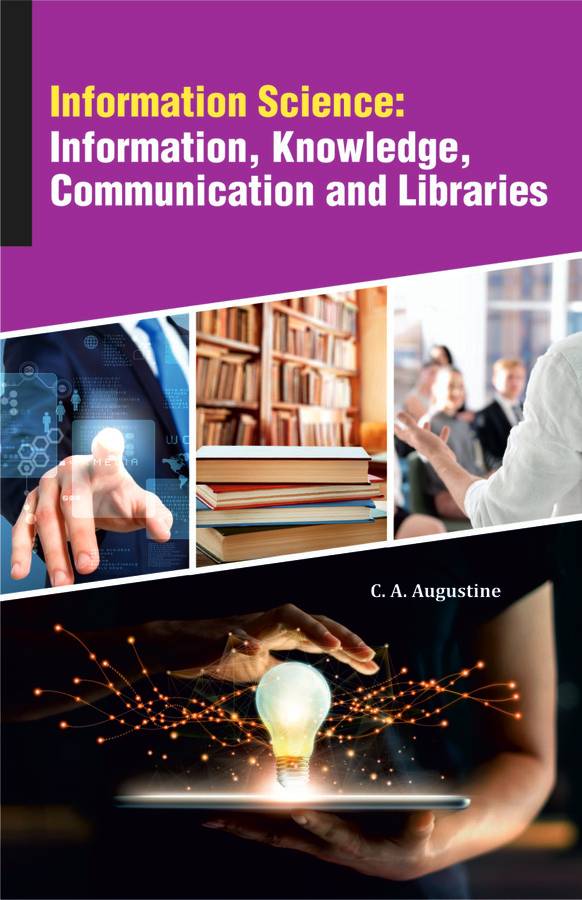Foreword
Preface
1 Information, Knowledge And Libraries
The Social Environment
Word meaning of Information
The Concept of Information
Information as a Measure
Information in Uncertainty
Information in Communication
Information and Knowledge
The Growth Process of Knowledge
Epidemic Theory of Communication
Data and Information
The DIKW Pyramid
Information Concept for Information Science
References
2 Information Science As A Discipline
Communication Process
Relevance of Information Science for Library Managers
Genesis of Information Science
Definition of Information Science
Content or Scope of information Science
Scope of Information Science for Librarians
Four Broad Areas in Information Science
References
3 Information and Its Importance
Defining information
Information and its uses
Information in Decision-making
Place of Scientific Information
Consequences of the Realization
1. Information Industry
2. Information Systems
3. Information Networks
4. Information Specialists
5. Information Technology
6. Information Science
References
4 Information and Communication Process
What is Communication?
Etymological Explanation
Communication in Biology
Communication as a Process
How Communication Works
Uncertainties in Communication
Role of Language in Communication
Signs, Symbols and Meaning
Difference Between ‘Signs’ and ‘Symbols’
Symbolic Interactions
Communication Models
Shannon and Weaver Model
De Fleur’s Model
Osgood and Schramm Circular Model
Lasswell Model
References
5 History of Human Communication
Non-verbal Communication
The Spoken Word
Invention of Writing
Development of Scripts
Writing Materials Used
Invention of Paper
Development of Printing
Other Developments in Communication
The Internet and the Social Media
Transportation
Major Events in Human Communication
The Spoken Word
The Written Word
The Printed Word
References
6 Properties and Behaviour of Information
Data, Information, and Knowledge
Information into Knowledge
Nature, Properties and Behaviour of Information
Growth Rate of Publications
Ageing and Obsolescence of Publications
Dispersion or Scattering of Subjects
References
7 Pattern of Scientific Communication
Informal Communication
Information Exchange Groups
Primary Publications
Journals
Alternatives to Journals
Research Reports
Secondary and Tertiary Publications
Under use of Information
Further Problems of Specialized Services
Libraries
Technical Information Centres
Invisible Colleges
Technological Gate Keepers
Scholarly Communication in digital formats/channels
Formal Communication
Websites and blogs
Open Access Publishing
Papers/Publications Over the Net (Originals)
Simultaneous Digital Versions of Learned Periodicals
Digital Libraries Online
Conclusion
References
8 Barriers to Communication Process
Barriers in Scientific Communication
Informal Communication
Channels
Primary Journals
Secondary Journals
Online Databases and Networks
Internet Facilities
Physical Access to Documents
Foreign Language Barrier
Overcoming the Language Barrier
1. Common Languages
2. Machine Translation
3. Foreign Language Teaching/Learning
4. Translation Departments
5. External Translators
6. Collections of Existing Translations
Publication of Bibliographical Tools and Indexes
Language Situation in India
Translation Services in India
Translation Processes
Translation Personnel
Artificial Languages
Copyright Barrier
What is Copyright?
History of Copyright
Exemptions from Copyright
Exemptions for Libraries and Archives
References
9 Bibliometrics
Genesis and Development
Bibliometric Laws
Lotka’s Law (Inverse Square Law)
Zipf’s Law of Word Occurrence
Bradford’s Law of Scattering
Reasons for Bradford’s Distribution
Other Works in Bibliometrics
1. Price’s Square Root Law of Scientific Productivity
2. Garfield’s Law of Concentration
3. Sen Gupta’s Law of Bibliometrics
Ageing and Obsolescence of Publications
References
10 Sociology of Information
What is Sociology?
Sociology of Information
User Studies
Significance and Relevance
Purpose of User Studies
Genesis and Development
Need for User Studies
Three Sub-areas of User Study
Who Constitute the User Community?
What All Things Can be Studied?
How to Study the Users?
Conventional Methods
The Diary Study
Observation
Non-conventional Methods
Critical Incident Method
Solution Development Record
Participant Observer Technique
Sociometric Analysis
Citation Analysis/Document Analysis
Experiments and Quasi Experiments in Field Settings
Psychometric Method
Cognitive Organization
Computer-based Research
Impact of User Studies
Patterns of User Behaviour
References
11 Economics of Information
Three Areas of Economics of Information
Information / Knowledge
Industry Knowledge
Industry Products
Information as a Resource
Special Importance of Scientific Information
Consequences of the Importance of Information
Cost Analysis
Costing: Importance and Relevance
Methods of data collection
Advantages/Uses of Costing
Concepts/ Terms
Main Steps Involved in Costing
Costing Methods and Techniques
Cost - Based Budgetting
1. Facilities
2. Equipments and Furniture
3. Salaries and Wages
4. Documents: (Books and Periodicals and Others)
5. Materials, Supplies and Consumables
6. Miscellaneous Cost-benefit Analysis
Three Sections of Cost-Benefit Analysis
1. Costs
2. Benefits
3. Return on Investments
References
12 Information Marketing
What is Marketing?
Information As A Product
Uniqueness of Information Products
Marketability of Information
Why Marketing of Information?
Marketing Concepts
Marketing Strategy
Marketing Stages and Steps
Setting the Market Objectives
Market Research and Segmentation
Product Development
Targeting the Products
Promotion
Promotional Mechanism
Marketing in the Digital Age
Distribution Pricing
How Are Prices Fixed?
Marketing Mix
Evaluation
Information Marketing In India
Conclusion
References
Bibliography


